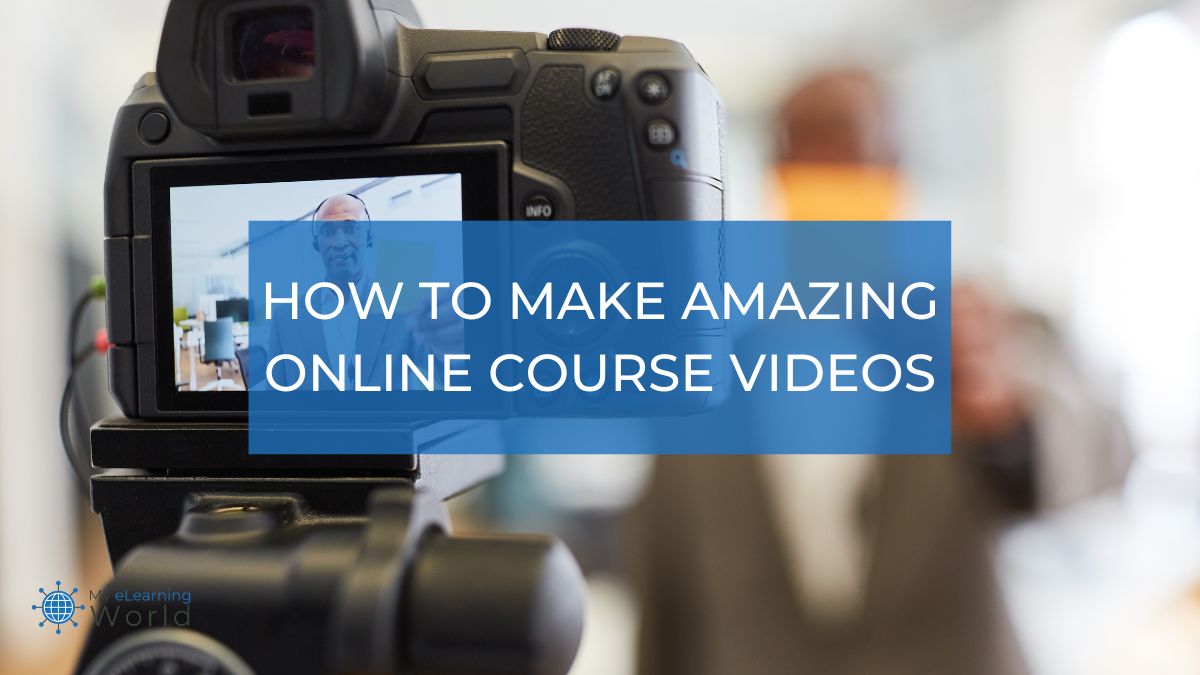Last summer, I had the opportunity to engage with university students at a conference, seeking insights into their experiences with video lectures and their engagement levels. Their unanimous response to where improvement was needed heavily focused on online course videos. If the lecture effectively meets their needs and engages them comparably to a physical class, online learning becomes an unparalleled medium of education.
In this article, I’ll explore how video lectures serve as a powerful medium of instruction and offer my tips on how to craft superior online course videos, from taking the time to craft a great script to using powerful video creators like VEED.
The Power of Online Course Videos
Online course videos play a crucial role in eLearning; they are, in fact, an integral part of the educational landscape. These videos offer an active and interactive mode of content delivery, potentially transforming the teaching and learning experience.
Here are some outstanding pros of online course videos and lectures:
- Visual Learning: Visual content is considered more powerful, engaging, and memorable than conventional text-based content. Unlike most traditional classroom lectures where imagery is limited, videos allow learners to visualize concepts through animations, demonstrations, visual aids, and real-life examples.
- Accessibility: Online course videos can be accessed from anywhere, providing learners with the flexibility to study at their own pace and convenience, completely eliminating the tediousness of travel.
- Interactivity: Many online courses include quizzes, polls, and discussion sessions to promote active inclusion, participation, and student engagement. The remarkable options to incorporate these activities in a video lecture make it all-encompassing.
- Self-Paced Learning: One of the best characteristics of course videos is that it allows viewers to rewind, pause, and replay lectures as many times as needed, offering them the opportunity to learn at their own pace and revisit challenging areas of study.
- Global Reach: Online courses can reach a global audience, making education accessible to people worldwide. This benefits learners seeking the best education and service-oriented educators aiming to bring knowledge to learners wherever they are.
Tips to Make Great Course Videos
1. Invest in Quality Equipment: Level-up Your Video Production Standards
I think quality is not just a preference; it’s the cornerstone of impactful content creation. Crafting high-quality online videos and lectures necessitates the use of top-notch equipment.
Here’s a breakdown of essential elements:
- Good Camera: Opt for a high-definition camera with commendable resolution and video quality. Even a smartphone equipped with a high-quality camera can deliver impressive results.
- No Camera? Use AI Instead: One thing I will add here is if you don’t want to appear on camera, another option is to create a realistic AI avatar or digital actor that can turn your text into professional-quality videos. VEED makes it easy to use natural, photorealistic AI avatars in your video that eliminate the need for you to appear on your videos, while still ensuring your online course videos have that human presence students respond to. It’s a great way to use AI in your eLearning experiences.
- Clear Microphone: Invest in a reliable external microphone to ensure a crisp and audible voice. Poor audio quality can be a significant hindrance to an effective learning experience.
- Proper Lighting: Illuminate your videos with proper lighting to guarantee clarity. Whether utilizing natural light or investing in softbox lights, the goal is to eliminate shadows and ensure a brightly lit video.
- Stable Tripod: A stable camera setup is paramount. Employ a tripod or stand to maintain a firm frame, preventing the unwelcome pitfalls of shaky and blurry video.
Learning from the best often involves studying the trend-setters. Consider Casey Neistat, a celebrated YouTuber whose exceptional video quality has become synonymous with success. Renowned for his steadfast commitment to utilizing top-tier cameras and audio equipment, Neistat has established an exemplary standard that aspiring creators can glean valuable lessons from. We can all draw inspiration from those who have achieved greatness and continually strive for improvement.
2. Script Your Content
I have personally experienced that even while making short videos, if we go unprepared, sequence gets ruined. A logical sequence is necessary to maintain the engagement and to keep the attention of a student intact. Too many breaks and cuts also have bad impact.
Prior to recording, always create a comprehensive script outlining the main points and structure of your video. A script makes sure that your content is well-organized, concise, and fluent. Consider using bullet points to make it easier to proceed.
If you’ve ever watched TED videos, you’ll notice that TED-Ed, the educational arm of TED Talks, excels in scriptwriting. Their animated lessons are meticulously scripted, ensuring that complex ideas are communicated in an engaging and accessible manner. The wow factor lies in the precision and planning of their content.
“In a digital age where attention spans are shrinking, creators of online video courses face a crucial challenge. Online learners, known for limited attention spans, benefit from concise content. Aim for videos lasting 3 – 5 minutes to sustain engagement. For extensive content, use sub-topics, ensuring focused and digestible segments for an enriched learning experience.”
3. Engage the Learners
Engaging your audience is vital for a successful online course and that is what determines impact and effectiveness of an online video lecture. If you intend to keep your audience engaged here are some strategies that can help you in keeping the learners attached:
- Storytelling: Ah, the magic of storytelling—an art that weaves through the fabric of learning, making it not just educational but downright captivating! Imagine your favorite book where characters come to life; similarly, in online learning, stories and real-life examples are the secret sauce. They transcend the digital world, bridging the gap between a virtual lecture and a heart-to-heart chat in a physical classroom and keep you audience engaged with the related stories and life lessons. It really helps in delivering any content and help the audience in remembering it for long.
- Visual Aids: Ever felt the power of a picture speaking louder than words? Visual aids create the biggest impact and if I put it right, actually they are the superheroes of Instructional Design. They’re not just about graphs, pictures, and animations; they’re the artistic sidekick that turns the mundane into a visual feast. Think of them as the Robin to your Batman, making complex concepts instantly accessible. Your learners won’t just understand; they’ll see the magic unfold right before their eyes. It will help them in understanding the concept more and create some new imaginations as well.
- Varied Presentation: Imagine a learning experience that goes beyond the conventional lecture style. Picture incorporating elements like engaging screencasts, live demonstrations that explain concepts in real-time, and lively whiteboard animations that turn complex ideas into visual journeys. The online learning landscape thrives on diversity, and your varied presentation style is the key to keeping learners hooked and eager for more.
- Interaction: Break the monotony of one-sided communication. You can increase more engagement by fostering interactions. Ask thought-provoking questions that invite participation, set up challenges that spark curiosity, or seamlessly integrate quizzes that transform passive watching into active learning. The internet is brimming with tools designed for this very purpose. In this digital era, interaction isn’t just encouraged; it’s a catalyst for a richer, more engaging learning experience in the eLearning world. .
- Keep it Concise: Research says that attention span is squeezing to unprecedented levels with passing time. Online video course creators need to counter this challenge. Online learners, especially, often have limited attention spans. Keep your videos brief and to the point. Aim for videos that are at most 3 – 5 minutes in duration to maintain engagement. If your content is extensive, consider breaking it down into sub-topics, ensuring each segment is focused and easily digestible for an enhanced learning experience.
4. Optimize Video Production
When creating videos, pay special attention to the following features to elevate the quality of your content:
- Editing: Utilize video editing applications and software to meticulously refine your videos. Remove errors, glitches, and mistakes, and add text overlays to emphasize key points. Enhance visuals and audio for a polished and professional finish.
- Transitions: Ensure seamless transitions between sections to maintain a smooth flow in your video. This not only enhances the viewing experience but also contributes to better comprehension and retention of the content.
- Thumbnails: Just as bees are drawn to attractive flowers, viewers are attracted to eye-catching thumbnails. Craft visually appealing thumbnails that entice learners to click and engage with your video. A compelling thumbnail can significantly impact the click-through rate of your content.
- Closed Captions: Promote inclusivity by incorporating closed captions into your videos where possible. This feature not only makes your content accessible to a wider audience, including those with hearing impairments, but also enhances the overall user experience. Providing captions ensures that learners can follow along, even in environments where sound may be restricted.
By prioritizing these aspects of eLearning video production, you not only enhance the overall quality of your content but also create a more engaging and inclusive learning environment for your audience.
5. Utilize Video Making Tools
 VEED - Edit, Record & Livestream Video - Online
VEED - Edit, Record & Livestream Video - Online
VEED is the fastest and easiest way to make high quality, professional videos for eLearning, business training, sales presentations, and other applications.
Incorporation of video editing software can make the learning and teaching experience even better. One of our favorite tools on this site is VEED. It provides a user-friendly interface and a wide variety of tools to enhance videos (see our full VEED review).
VEED offers a range of features that make eLearning video creation a breeze:
- Swift Editing: It allows you to edit your videos easily, trim clips from desired timestamps, add captions, and include graphics.
- Automatic Subtitles: VEED provides automated subtitle facility, hence making it east to add subtitles and closed captions in your videos.
- Collaboration: Tools like VEED support offer option for collaborative editing, letting multiple editors in a team to work on a video at the same time.
- Export Options: VEED offers various export options, including different video formats and quality settings.
Using video maker/video editor can help you create an engaging course video, eventually benefitting students’ learning experience.
6. Gather Feedback
In online video courses, it is significant to encourage students to give feedback on your course videos and overall learning experience. Their input and suggestions can help you identify areas for improvement and enhance the quality of your online courses.
Final Thoughts
All in online education is transforming the way teaching and learning is carried out and online course videos are at the forefront of this revolution. Let’s summarize it all. To make great online course videos:
- Invest in quality equipment.
- Outline your content.
- Engage your audience!
- Keep it concise!
- Optimize video production.
- Choosing host website wisely
- Interact with your students.
- Regularly update your content
- Incorporate video tools (like VEED)
As technology continues to grow, the potentials for refining online course videos are limitless. By applying these actionable tips, instructors and learners can benefit from a more engaging, interactive, and effective online learning experience.


